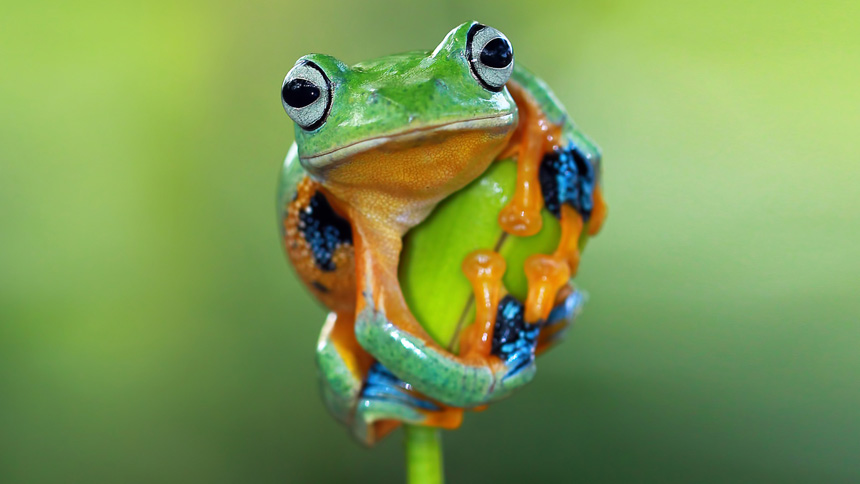
The Best (And Worst) Frogs for Beginners
Keeping frogs as pets is a rewarding experience, for both young and old. It’s not incredibly difficult either. In fact, caring for most frogs is as simple as maintaining the correct temperature and humidity, feeding them daily, and cleaning their habitat.
Hobbyists mess up, unfortunately, when they fail to properly research the species of frog they’re keeping. Some frogs are hardy, don’t require much attention, and can withstand the occasional mistakes from their keeper.
Others are fragile! Even the smallest mistake can prove fatal. That is exactly what this post aims to cover; the best and worst frogs for beginners.
By the way, I won’t go into great detail on how to care for the Anura (frogs and toads) on this page. The reason is simple, I’ve created in-depth care guides for most of them!
Page Contents
The 5 Best Frogs & Toads for Beginners
When determining the best frogs for beginners, I had to establish some criteria. I decided the upkeep should be minimum, the cost low, and most importantly, the frog should be hardy.
A beginner-friendly frog should be able to withstand the typical mistakes newbies are bound to make and their habitat should not be expensive or complicated.
With that in mind, I’ve come up with a great list of frogs that meet these criteria. They’re outlined and described in the section below.
I did my best to include each type of frog; terrestrial, aquatic, and arboreal.
- Terrestrial frogs are notoriously easy to care for, they include species like toads and other mostly land-dwelling frogs.
- Aquatic frogs aren’t quite as well-known but they’re available and the one I selected is very easy to care for.
Then there are the arboreal frogs (treefrogs). This one was difficult. Tree frogs are usually a bit more difficult to care for. They require a vertical terrarium and most of them are fragile. But fear not, I’ve got the perfect tree frog for beginners and you can read more about them below.
African Dwarf Frogs
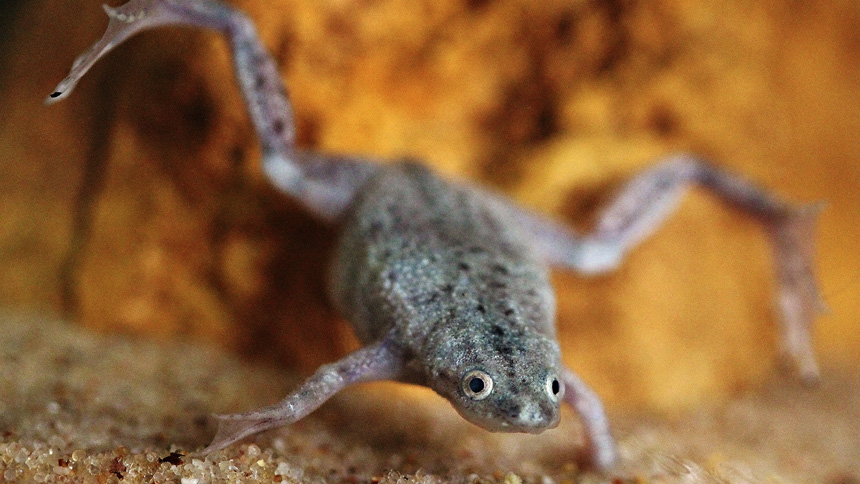
The only aquatic frog on this list is the African Dwarf Frog. There are several aquatic frog species around the world, but none are as easy to care for as the ADF. That’s my opinion anyway.
African Dwarf Frogs are often confused with African Clawed Frogs, even in commercial pet stores. This is due to their incredibly similar appearance. Both are very easy to care for, but the ADF seems to be more commonly available.
To keep an African Dwarf Frog, you’ll need a 10-gallon aquarium minimum. The size of the tank depends on your preference and your wallet. You can go as big as you want, just be sure the height of the aquarium is no more than 12″.
These frogs, while aquatic, need to swim to the top of the water to catch a breath of air once in a while. Due to this, it’s best to keep them in water no deeper than 12 inches.
Feeding them is fun and simple. They’re known for eating just about any type of organic material that floats in front of them. Also, it helps that specialty food is available.
This is due to their popularity, of course. They’re sold at virtually every pet store you walk into. For more information on African Dwarf Frogs, check the care sheet section of this website.
For more information, see our African Dwarf Frog care guide.
Bumble Bee Toads
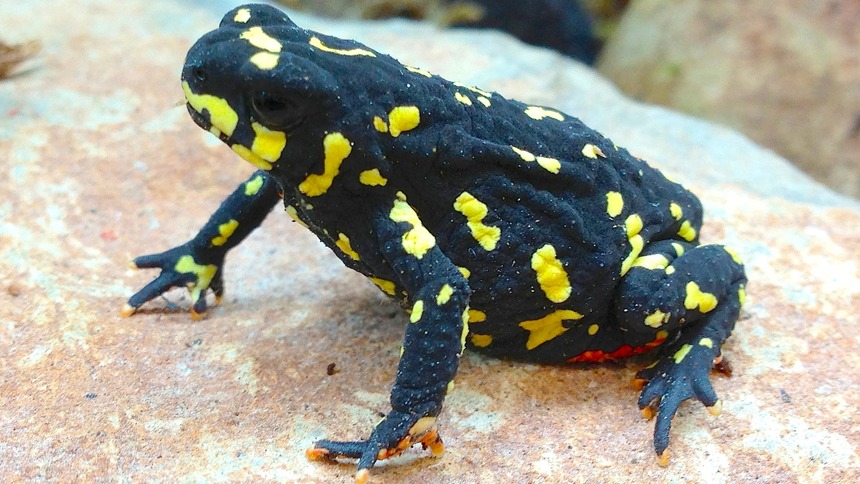
Red-belly Toads from South America are often confused with another type of frog, a more popular species; The oriental fire-bellied toad. Both of which are easy to care for but these are easier. They’re great for beginners.
They require such small space that a 10-gallon terrarium might actually be overkill. A 10-gallon critter cage will easily hold 6 red-belly toads, maybe more.
The chores to caring for these frogs are typical; feed and mist daily, change the water as needed, and clean occasionally. Probably 15 – 20 minutes of upkeep each week. Feeding them is a little different than larger frogs.
Because they’re so small, they need a diet consisting of tiny insects. Things like fruit flies, springtails, and pinhead crickets. All of which are available online or in commercial pet stores.
For more information, see our bumble bee toad care guide.
American Toads
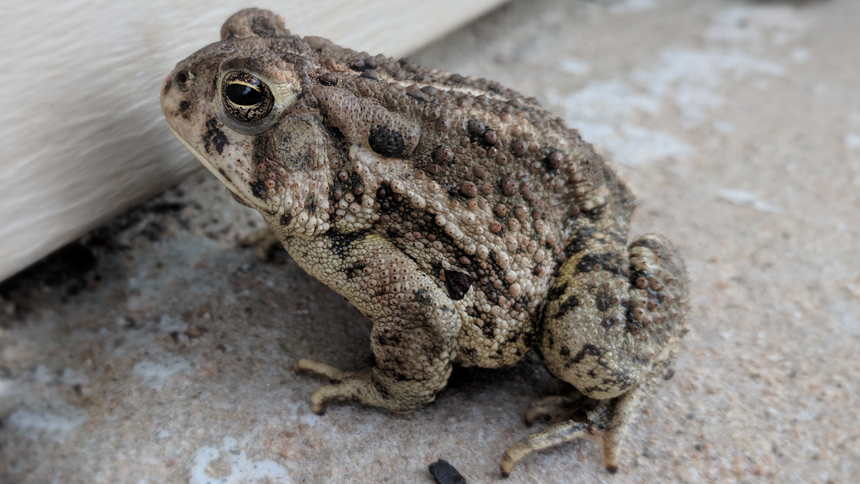
American Toads are the epitome of the perfect frog for beginners. Well, they’re actually toads. True Toads to be precise. You see, there is a difference between a frog and a toad but that’s a topic for another post.
Anyway, American Toads (Anaxyrus americanus) describes three species; the Eastern American toad, Dwarf American toad, and Hudson Bay toad.
The reason they’re so easy to care for is that they require so little. They will eat nearly anything you put in front of them, a 10-gallon terrarium will suffice, and they’re really hardy. Most people don’t seek out a place to buy them because they’re usually caught in the wild and kept as pets.
While I certainly don’t agree with doing that, it’s just the way it is. I remember being a kid and keeping basically anything my parents would let me, American Toads included.
That’s not an excuse to treat them poorly though. They still have requirements. A nice substrate like eco earth or plantation soil in a 10 to 20-gallon terrarium with a small, shallow water dish is needed.
Clean, dechlorinated water should be provided at all times. Also, a nice hollow log, some leaf litter, and plants (real or fake) will help them feel more comfortable. They should be fed regularly and their food needs to be dusted with calcium and vitamin supplements.
For more information, see our American Toad care guide.
Pacman Frogs
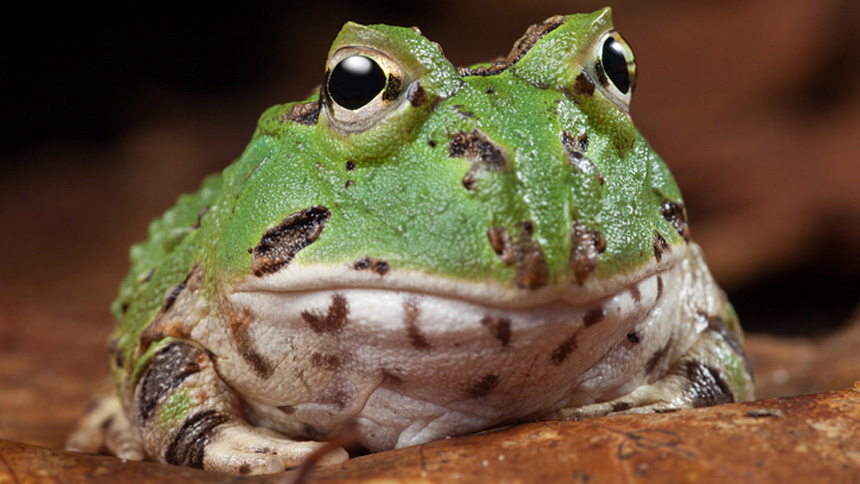
There are currently 8 species in the Certophrys Genus, all of which are commonly referred to as Pacman Frogs. Another common name they’re known by is “South American Horned Frog”.
These are easily the 2nd most popular frogs kept as pets today, second only to poison-dart frogs. And for good reason; their looks are amazing, it’s fun to watch them eat, and they’re super easy to care for.
They spend the majority of their time burrowed into the substrate. Also, they’re nocturnal so you won’t see them moving around very often. When you do get a chance to observe them, it’s quite entertaining. Their plump, round bodies and gigantic mouth make for quite the spectacle around feeding time.
As far as supplies and availability, buying a Pacman Frog won’t set you back too much. A 10-gallon terrarium, some coco-husk fiber substrate, a small water dish, and maybe a plant decoration and you’re good to go.
Of course, you’ll need food too. They eat the common items you can readily pick up at your local pet store; crickets, mealworms, waxworms, pinkie mice, etc. As far as the price goes, you can usually find these guys for $20 – $40. A rare color morph might cost a little extra but that’s to be expected.
One thing to know about these frogs is they’re cannibalistic. Only one Pacman Frog should be kept in a terrarium. Should you decide to breed Pacman Frogs, things might get a bit tricky. Ensure they’re well fed before introducing them into the same enclosure. Anyway, if you want to learn more about these frogs, check out our Pacman Frog care guide.
Tomato Frogs
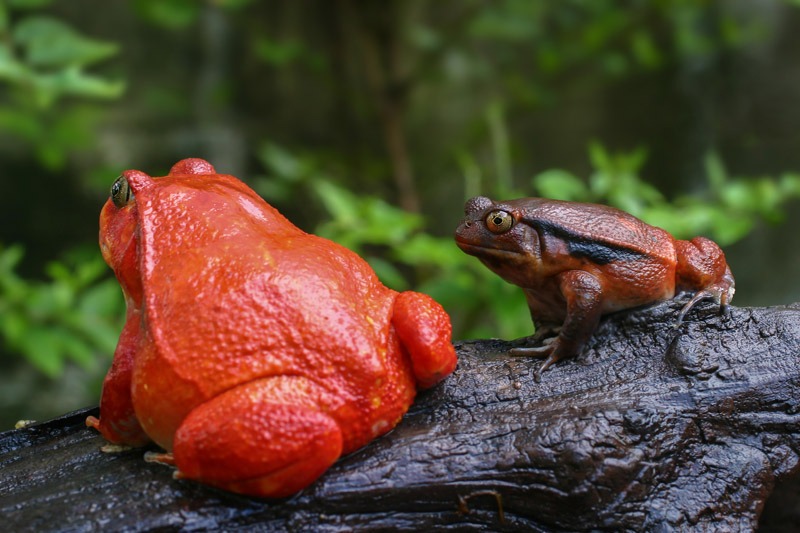
Tomato Frogs are one of the most popular frog species, regardless of difficulties, due to their bright coloration. It’s easy to see where their name came from. They’re bright red with a black line spanning half the distance between their eyes and hind legs.
I consider tomato frogs to be similar to Pacman Frogs in terms of difficulty. Both of them burrow into the substrate while waiting for unsuspecting prey to walk by and they don’t require a lot of room.
As far as tank size is concerned, a single tomato frog can be housed in a 15-gallon enclosure. The cool thing about these amphibians, as opposed to Pacman Frogs, is that you can safely house two or more in the same enclosure. They’re not nearly as aggressive.
Tomato frogs do well in a room-temperature environment, although a supplemental heating element may be required for daytime hours.
The main concern I have about adding this species to the list of beginner-friendly frogs is due to humidity. They love and need a high-humidity environment. I absolutely recommend new hobbyists read about their requirements because purchasing one! That goes for all frogs, of course.
For now, just know that you’ll need a hygrometer to monitor the humidity levels, and a nice spray bottle to mist their enclosure. You’ll likely need to do this a couple of times per day.
Gray Tree Frogs
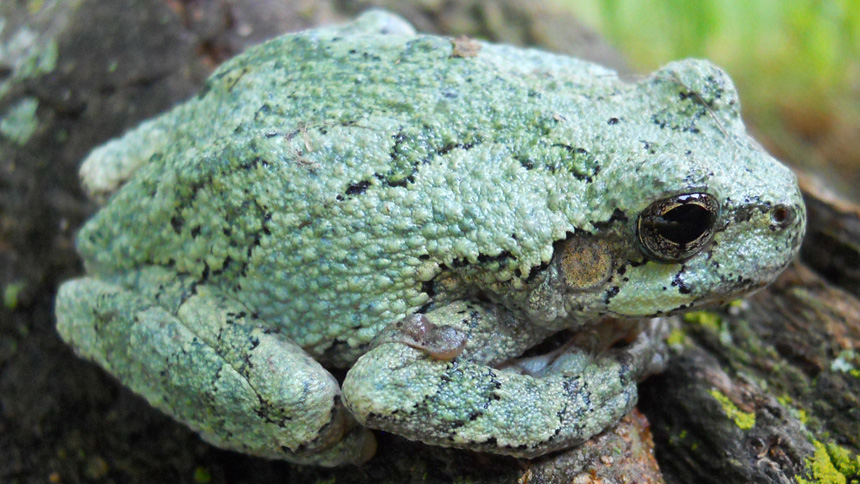
I spent some time debating whether or not to add Gray Tree Frogs to this list. They’re not very difficult to care for, but they’re a little more complicated than your average toad. When I consider a frog “easy” to care for, I look at the upkeep time and how delicate the frog is. Most frogs are actually very easy to care for, but some of them are more delicate than others.
The Gray Tree Frog is not one of them. They’re fairly hardy, especially for a tree frog. That’s the other reason I added them to this list, I wanted to recommend a good tree frog for beginners.
One of the neat things about the Gray Tree Frog (Hyla versicolor) is its ability to change colors. If you’ve never heard about this frog, you’re probably looking at the picture above and wondering why I keep calling them a “Gray tree frog”. Well, it’s because they can be gray or green, depending on their surroundings.
I actually found a large one hanging out on my in-law’s window this week. My son HAD to hold him. So after washing our hands in a nearby rain puddle, I grabbed the frog and handed him to my son. He loved it. The frog, not so much. He jumped off the first chance he got and we watched as he disappeared into the grass.
He was in great shape, had thick, strong legs, and had a healthy body. Their overall size is small, but for a treefrog, they’re kind of big. They’re a far cry different from skinny Red-Eyed Tree Frogs. Anyway, I told this story as an example of how hardy they are compared to other tree frogs.
They need a vertical terrarium. Something taller than it is wide. An 18″ x 18″ x 24″ terrarium will house several Gray Tree Frogs. A smaller terrarium, 12″ x 12″ x 18″ will work for one to two at most.
They can be kept at room temperature or a little warmer. They will tolerate a wide range of humidity levels but it’s best to mist their enclosure twice daily. Keep the humidity around or above 50% or slightly higher. An occasional spike in humidity is recommended.
For more information, see our Gray Tree Frog care guide.
The Worst Frogs for Beginners
Now that we’ve taken a look at the best frogs for beginners, let’s have a look at the worst frogs for beginners. These frogs are here because they’re expensive, delicate, take a lot of upkeep, or their setup is complicated.
Remember, don’t be discouraged by this list. You should get the frog or toad you want. It’s as simple as that. My only recommendation is this; do the proper research before buying it. Prepare a nice enclosure and learn everything you can about the species first.
Poison Dart Frog
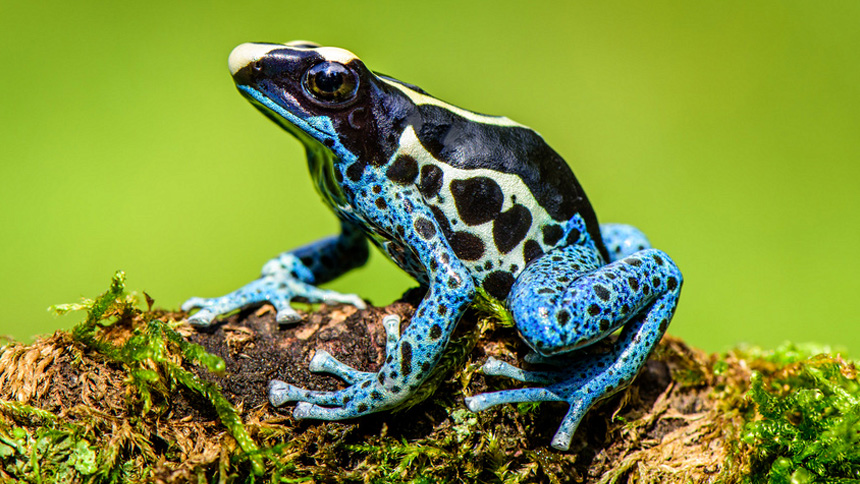
Poison-dart frogs are undeniably cool. They’re colorful, coming in exotic patterns and bright colors. Sure, they’re potentially deadly in the wild but in captivity, they’re virtually harmless.
You see, the reason they’re so deadly in the wild is that they feed on alkaline-containing insects. In captivity, they’re given fruit flies, pinhead crickets, and other small insects. Because those insects don’t contain alkaline, the frogs aren’t poisonous.
So, if that was something you were worried about, don’t be. It’s safe to keep captive-bred poison-dart frogs as pets so long as you don’t feed them alkaline-containing bugs.
Anyway, the reason these frogs are one of the worst for beginners is their requirements. The humidity level needs to stay above 80% at all times. This requires several things.
An automated misting system is recommended, which mists the terrarium for you, keeping the relative humidity in the desired range. Since a lot of water is used to keep the humidity high, a drainage layer is needed to keep the substrate from becoming soggy.
The other thing is, you’ll likely need to cover most of the ventilation in order to keep the humidity high. Poor air circulation can lead to a list of other problems.
I certainly don’t want to discourage you from ever getting poison-dart frogs! My point is; they’re one of the worst frogs for beginners. A more sophisticated setup is needed to provide a healthy environment.
To learn more, see our dart frog care guide.
Vietnamese Mossy Frog
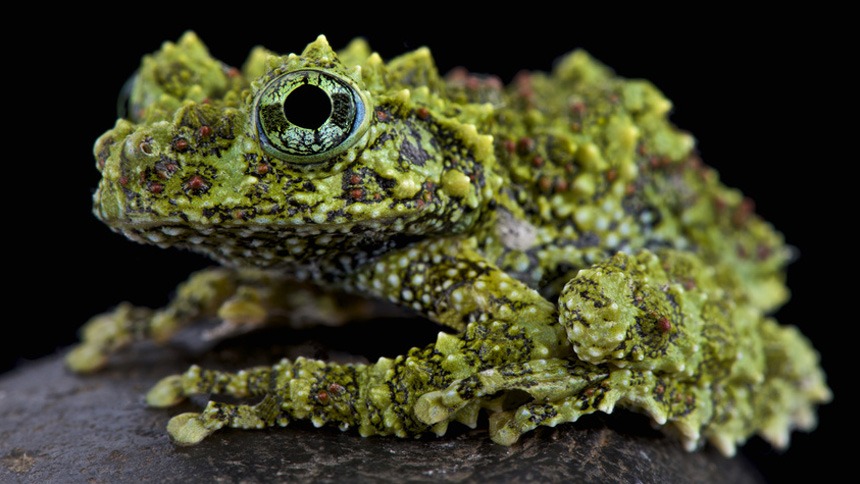
Vietnamese Mossy Frogs are among my all-time favorites. With their bumpy, green skin and big, round eyes, it’s a wonder why they’re not more popular. They’re a little more complicated to care for than most frogs though.
One of the best setups for a mossy frog is called a paludarium. A paludarium combines both land and water, live plants, and live fish as well. Now, that setup is not required. What is required is a decent amount of water, a relatively high humidity, and a temperature that never goes above 75 degrees Fahrenheit. At least not for an extended period of time.
Mossy frogs are one of the worst frogs for beginners because of the upkeep and complicated enclosure setup. Some people keep them in a terrarium with a full water bottom and add cork-bark flats as floating islands, which is easy enough to accomplish.
Partial water changes are needed and if you want to use live plants, real fish, and create a land area with a substrate, it becomes complicated. As a beginner, the health of your frog should take center focus. Live plants, drainage layers, air circulation, and other factors can be a distraction.
To learn more, see our mossy frog care guide.
TLDR; The Best & Worse Pet Frogs for Beginners
This article is meant to point new hobbyists in the right direction. Because of this, I establish a set of criteria for labeling a frog as “beginner-friendly.” Listed below are the attributes:
- The frog should be hardy and capable of withstanding small mistakes beginners often make.
- Their habitat/enclosure should not be expensive or complicated.
Amphibians are delicate creatures. They require temperature and humidity ranges within a certain window. Also, feeding them is more complicated than grabbing a bag of food like you can with a cat or dog. Frogs eat live insects and it’s a good idea to supplement those “feeders” with reptile vitamins and calcium.
Moreover, one needs to monitor the humidity and temperature in order to make adjustments to keep them healthy. Still, the frogs listed above (in the best for beginners category) are fairly hardy.
I hope this guide helps you get started! Feel free to browse the website to learn more about frogs.

73 Comments
Are green frogs good for beginners?
Also, can green frogs live happily with wood frogs?
I live in Australia, and I’m having trouble finding a place to buy frogs. I was all read up on Whites Tree Frogs, until I realized that I can’t buy them anywhere near me. The only shop that sells frogs is around 2-3 hours away in my city, and they only sell Magnificent GTF, Red Eyed GTF, and White-lipped GTF. The Magnificent one is too ‘Magnificent’ for my budget, as I’m 14 and buying everything with my own money. Which frog out of the other two is best for a first-time-froggy-owner? Thanks!
Also, when buying a frog from a pet store, what should I ask and look for to make sure they’re okay and healthy? Eg. Who their suppliers are, if they’re licensed breeders, if the frogs were bred in captivity at all, etc.? Also, since it’s such a long drive home, how should I transport the frog in the most comfortable way? Thanks, again!
Hey Bella!
I recommend asking your parents for permission and help in doing this! I’ve had success finding local breeders on Facebook. Also, often-times reptile conventions will list breeders on their website. These are the people who rent booths in order to sell reptiles and amphibians. Usually they have a website or contact information. Doing this could yield some results in finding a local breeder! Those tree frogs will all be similar in difficult btw. Red-eyed tree frog has my vote! For transporting long distances, just be sure to have a nice carrier with water in it. The humidity should be high. You can use Tupperware or a similar plastic container with some type of ventilation!
Hello!
I live in Wyoming (very dry – low humidity).
I was looking at getting a frog or toad. I was thinking of either of the following:
White’s tree frog, Tomato Frog or PacMan frog.
The enclosure choices I have here are standard aquariums 20 L etc. or I can purchase a 25 gallon Zoo Med terrarium (13.5 x 31.5 x 17.5).
I want to set myself up for success and be a good “frog-daddy” ; )
Which of the above would be a good choice?
I am not interested in handling them very much, watching movies with them or napping on the couch with them. I have no interest it putting them in my mouth (!) LOL.
I am looking for a pet to watch that is not too difficult to care for.
Any help would be great!
Kindest regards,
John
Hey there! Sounds like you’re off to a great start! Both the Pacman Frog and Tomato Frog are ambush predators. They will do well in a horizontal-style aquarium/tank. You won’t see them very often, or at least not much of them! Oftentimes I can only see the eyes of my Pacman Frog because he is burrowed in the substrate. He’s very fun to watch while eating though! The White’s tree frog will likely sleep most of the day! They perk up at night time! None of the species listed is too difficult to care for either. Would you consider doing some research on the different types of Pacman Frogs and perhaps make a choice on one of them? That’s a thought!
Hi i was considering buying a few tinctorus dart frogs for a 29 gallon terrarium and I think i would be able to keep up with the humidity just fine. humidity aside do you think they are a good beginner frog?
We’re looking into a frog/toad for our 4 year old who is frog obsessed. I want something easily kept without a ton of upkeep, we were considering the Pac-Man frog but I’m kind of anxious about the level of aggression I’ve read in some places. He won’t be handling besides when cleaning or feeding, my main concern is just how aggressive are they? Thanks!
Hey! I got my son a Pacman Frog when he was 4! We still have him. Also, I have another son who is currently 2. I’ve only allowed them both to hold him once or twice because frogs, especially Pacman Frogs, don’t do well being handled. Having said that, I’ve been bit a couple times while feeding him. Its because I got my fingers too close. They’re not super aggressive but if your finger gets a bit too close, you might get bit!
what are good choices for a LAND frog or toad
Do you know anything about Bushveld frogs and whether they can be purchased in the US?
Hi, Shannon! Bushveld frogs look a lot like Notaden bennettii. Unfortunately, I don’t know of a place to get either of them. You could keep an eye on morphmarket.com but these species aren’t common in the trade. I’m sorry I can’t be more helpful.
I’m 14, and i want to find a kind of tree frog that you can hold a lot without it getting hurt or unhappy, that alsoniant bad to touch, and thats not too expensive to provide for, what do you suggest?
Hey, Kanna! Honestly, I wouldn’t recommend any frogs for handling a lot. A dumpy tree frog will occasionally tolerate handling but I try to encourage people not to hold them too much. I really hate to tell people this because I feel like I’m discouraging them from getting a pet frog. That’s not the case. Frogs are great; just not so much for handling. I recommend something like a leopard gecko if you want something to handle often.
A White’s Tree Frog is a great option. They tolerate handling better than any other frog I know. You still shouldn’t handle them so often, but every once in a while is okay. I think about 30 mins every few days is fine. Gloves should be warn, but you an also wash your hands really well. My way is washing once and rinsing three times. Make sure there’s nothing on your hands because the frog’s skin will soak it up. There care isn’t too demanding or expensive, but do proper research before choosing any frog. A minimum of 3 sources. They all have their flaws so take that into consideration when deciding.
Hi Sav, this was very helpful. This really helped because me and my friends both love frogs and we wanted one that we could hold for some amount of time.
white tree frogs are your best bet but like people have said frogs aren’t the best animal for handling, they absorb things through their skin so handling can be dangerous for them and also depending on the species it can extremely stress them out, all the frogs i’ve owned do not like being handled, but if you want an animal you can handle regularly and make a bond with (which arguably you can’t do with a frog) i’d suggest a gecko, such as leopard or crested. either way look on local reptile/amphibian facebook pages or on craigslist where you can find an animal in need of a home instead of supporting a big pet store
Dumpy frogs, great with being held.
Just not more than up to 10-15 minutes without gloves.
HI John, I have downloaded your guide & have just started going through you site which is amazing 🐸 I have a Frog Hotel & I’m about to do a Pond so I’m learning & it’s fun, is it possible to buy your guide in book form as I’m a lover of Books 🐸🐸
I’m looking for a rather interactive species of Frog or toad that won’t need a lot of space, but everytime I think I found one I read something that doesn’t fit the bill… Any ideas ? I was thinking about an american toad or tomato frog because they aren’t that active in their cage, but can be interactive while feeding. I’m jus a bit at loss here. this would be my very first amphibian..
You might consider a Pacman Frog. They mostly just sit there all day, burrowed in the substrate. They’re aggressive eaters, too. They’re fun to watch!
What are the best ONLY water frogs to get? Thanks!
African clawed frogs are popular aquatic pets.
I would suggest an African Dwarf Frog, actually. You can get multiple, and they do well with fish in their tank. An ACF will attack anything it sees, and you can only have one. ADF are cute and friendly. You can even teach them tricks! Be careful that you’re buying from an experienced breeder, as ACFs are commonly sold as ADFs, which are illegal in many places.
Hi so i really want a frog, i know they are a little tricky to care for and was wondering what your suggestions were. I am 14 and originally started looking at an american green tree frog but realised it was very expensive as a sart up cost and a little trickier to handle than other forgs. I would quite like a smaller frog so not one quite as big as a whites tree frog, and also a frog that has a small setup fee as im only 14 and paying for it myslef. My parents still need a little convincing so i want to know as much as i can before i try to persuade them. Your site has already been really helpful to me and i would really like a little help with regards to my issue. Once again im looking for a frog that is reasonabky small( smaller than a whites tree frog), has small startup costs and is okay to be handled on occasions. Any help would be great 🙂
Hi, Heyleigh! A bumblebee toad would be a great pet to start with. Really, a lot of toads are easy and inexpensive to care for. Perhaps a Pacman Frog? They don’t require too much of an investment! Of course you’ll want to talk with your parents about this first.
Somewhat unusual question: What would you recommend if I wanted to keep some non-toxic, hardy and locally native frogs as free-range residents in a dirt-floored greenhouse with in-ground plant beds, so _without_ a dedicated frog enclosure? We love frogs and toads, and they could certainly help keep pests under control (and of course I could release additional food for them and could provide various habitats in the room, mist regularly, etc.). It would be best if they were native to the upper midwest in North America and could tolerate a reasonable range of temperatures (more or less like being outside, but the space will be kept above freezing), rather than only being able to live in a tightly controlled tropical terrarium. Just American toads, maybe? Maybe local North American gray tree frogs? I’m not sure what species could be happy and thrive in those conditions but would love to try. Thanks!!
That is a good question! Honestly, probably any of the local frog species would do well.
Just a couple tips. Some things to consider. A water source would necessarily. Something with clean, dechlorinated water and easily accessible. Food during the winter months will probably be needed.
Also, I’m curious about the maximum temperature in the greenhouse during the summer months? Is it something the frogs can withstand?
Now you’ve got me wanting to write a helpful tips guide on this subject 🙂
hello, i am new to frogs and i’m very interested in a rain frog what size enclosure do you recommend i know they like to burrow. are they good pets for children (10 and 13years) the children won’t be the primary care taker of course. thank you 🙂
I wish I could say I’ve kept a desert rain frog but I have not. They’re cute! I love those little frogs lol. I can’t recommend getting one either way. The best frog for kids would be a White’s Tree Frog. They’re the only frogs that tolerates handling. Even then, they shouldn’t be held much at all! If you’re looking for a small pet your kids can handle often, I recommend a Leopard Gecko!
hi! what is a good frog to handle often and let out of its habitat sometimes?
The best to handle is a White’s Tree Frog. However, they still shouldn’t be handled very often. Honestly, amphibians are pets which should be admired from within their enclosure. They’re very delicate. If you’re looking for a good, small pet you can handle often then I recommend getting a Leopard Gecko.
How noisy does a single whites tree frog get? I’m moving to college in a year and I’m trying to be mindful of roomates before I get a frog
White’s tree frogs can be noisy lol. Check out some YouTube videos to get an idea.
Hi I want a whites tree frog how big of an aquarium and what do they eat.
Hey, Will! Check out our care guide for white’s tree frogs. It should answer all your questions and more.
i have my red eyed tree frog and i am on the second day. i want to know if it lying on the ground and sleeping all day is healthy. i know it is nocturnal. The substrate is a mix of sphagnum moss,soil and coconut bark but it is sticking to my frogs sticky pads what do i do?
or should i leave him alone ?
For now, yes!
My RETFs did this the first day I had them. One thing I recommend is to check the humidity and temperature to make sure its in the correct range. Sometimes frogs will seek extra humidity via the substrate (as it retains humidity).
hey… is it allowed to have a Wallace flying frog be a pet in New York?
Hi! Great question. I don’t live in NY so I’m not the best person to answer that question. Here is a link with a PDF including many prohibited wild animals. I hope it helps. Do your research 🙂 good luck!
are red eyed tree frogs good for beginners?
I would say they’re intermediate. A RETF could be a good beginner frog so long as you do a lot of research and careful planning on the enclosure. You need to be aware of the humidity and diet with them.
At what size is a froglet big enough to fend for itself and can be released back into the wild? I rescued some tadpoles from a mud puddle that was drying up and now they’ve transformed into froglets. I’d like to return them to their habitat but don’t want to do it before they are able to take care of themselves. Also, what type of habitat do they require at this stage (their tails have just disappeared) of life and what do they eat? Thank you!
I’ve released some when their tails are absorbed and they’re hopping on land. They can eat small things like wingless fruit flies. A small enclosure will work fine! Something with water and substrate to walk on.
Hello John! So, I’m making a terrarium for school and want to put a frog in it. The terrarium will stay at home, what frog is the cheapest and easiest? The terrarium is a big pickle jar that is not going to fit the standard stuff. Also what would I put in the jar? Thanks in advance!
I don’t recommend using a big pickle jar as an enclosure for a frog. An 18″ (tall) x 12″ (wide) x 12″ (deep) terrarium would be a good starting point!
Hi, I have a red eyed tree frog I’m new with frogs I’m trying to figure out about heat/light for her and as well I’ve tried to feed her crickets but I believe they were too big and since I’ve reasearched some Many people said the cricket shouldn’t be any bigger than the distance from eye to eye. If you could give me any advice or tips I’d really appreciate it.
The cricket shouldn’t be any bigger than the width of the frog’s mouth. Naturally, you don’t want crickets too big to fit in your frog’s mouth. I recommend checking out this post about Red-Eyed Tree Frogs. Lots of helpful information!
Im looking for a frog for my dad and he really likes the African rain frog would that be a good starter frog or no?
I’ve never cared for them so I can’t suggest either way. My recommendation is to see what all is available in your local area and go from there!
Would it be possible for me to keep a frog in a 5 gallon tank?
It could work temporarily for a juvenile toad. For an adult, I wouldn’t go any smaller than 15 gallons (depending on the species).
Oh ok thank you! I don’t really know what to do with my tank then ):
You could store crickets in it!
Are the tiny Spring Peepers or Cricket Frogs suitable as pets?? If so, what should they be fed and how often??
I haven’t kept them as pets so I couldn’t tell you either way. I’m sorry! I know spring peepers are pretty small so I would feed them pinhead crickets or wingless fruit flies. I would try feeding them 3 – 4 times per week. Enough food to keep them healthy. Usually you know you’re over feeding them when they have left over food a few hours after you give it to them. Pinhead crickets and fruit flies are hard to count so experiment with the amount you feed them.
I have what i believe is a gray tree frog thats been living in my half bath sink for about 2 weeks now, my roommate’s daughter named him Edward. He was hanging out literally in the overflow drain for about a week and i didnt mess with him because hes not hurting anything. The other day i found him on the floor with something stuck to his food and a hair wrapped around it, i put him back in the sink cut the hair and washed off what ever was on his foot that he kept trying to scape off himself. I used my hand to funnel the water onto him and he stopped kicking tilted his head back and just let the wash happen. Now i wanna keep him, i saw i need a vertical terrarium but what does he eat? I dont even know how hes been surviving in the sink for this long.
That’s awesome! Check out this guide on what frogs eat. It should answer most your questions.
I found some frog eggs outside in my pond i think they are pacidic tree frog eggs this is my first time with frogs so im wondering if its worth waiting for them to hatch so i can have a pet frog
That’s one of the better ways to get a frog from the wild – as tadpoles (all things considered). Please do a lot of research before hand! Tadpoles are delicate. More so than adult frogs but so are juvenile frogs. I don’t recommend taking frogs from the wild because it’s stressful for them.
I’ve recently taken a northern green frog out of the wild because he was flopping about like a tumbleweed in the hurricane (i guess he didnt reach his burrow in time) and i had a terrarium on hand. He did seem stressed and timid for the first week or so but after that he adjusted nicely, he’s active, croaks his head off at night and doesn’t even flinch when my siblings open the terrarium to poke him (despite me urging them not to)
I’m glad he adjusted so quickly for you!
What are your thoughts on Budgett’s frogs as pets? I have been considering getting one. They seem move active and having a paludarium is appealing to me. Also, what kind of terrarium/paludarium would you have for a pixie frog? I know they are ambush predators, but they like to swim.
Both the Budgett’s and Pixie frog look like they would be interesting to keep. I haven’t had either of them but I know Pixie frogs get big. They require a large tank. I think a paludarium for one of them would be really cool but challenging. You would need to be clever about it because their size and because they burrow. You’d want to strategically place the plants where it would be hard for them to get messed up. The plants would need to be hardy too lol. Something that could withstand a giant pixie jumping on it.
Many people say budgett’s frogs are medium-hard.
pixie frogs are awesome, although ive never had one. I think they would be a larger commitment, though. they can live 15-20 years, and grow BIG!
Are whites tree frogs hardy? In a general sense.
Yep! Well, compared to most frogs.
I hope to cajole my mother into getting me a tomato frog today. What I have learned on this site already has been very useful.
Good luck! Thanks for the comment 🙂
Can you help me? I have no idea where to find a White’s Tree Frog, though I’m considering buying one.
Where do you think I should look?
Hi, Gabi! You know, I really need to make a post on where to buy frogs. I’ll do this soon. You have a number of options; check reptile conventions, local pet stores, check Facebook for local amphibian breeders, online, etc. Morphmarket.com is a good place to look!